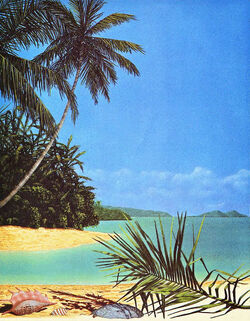

The most important isolated environments on Posthomic Earth lie on the South American continent and on the oceanic islands of Lemuria, Batavia and Pacaus. The accident of geographical separation has given these areas quite distinct animal communities.
Isolation is one of the most important mechanisms of evolution. When a group of creatures becomes separated from the main breeding population, the separated group evolves independently of the parent group because there is no longer any possibility of interbreeding. The new group interacts with its environment, changing into new forms and evolving along lines that would be totally closed to it if it were living among its original enemies and competitors. This phenomenon is particularly marked where animals become isolated in sparsely or hitherto unpopulated areas and is nowhere better seen than on the islands of the oceans.
There are two main varieties of isolation in this context, each producing its own environmental pressures and giving rise to its own forms of evolution.
The first takes place when one continental mass splits away from another. What then happens to their fauna is largely dependent on the subsequent movements of the two continents. One land mass may drift northwards or southwards with respect to the other, subjecting its fauna to new climatic and environmental conditions which could affect their evolution and ultimately lead to the production of totally new genera and species. Exactly this happened during the Mesozoic, when the South American continent, which had shared the same dinosaur fauna as Africa, split away, resulting in the evolution of totally different animals in each area.
When a drifting continent collides with another, very often a considerable interchange of faunas takes place between the two land areas. It may happen that the fauna from one continent completely replaces that of the other. This happened when the small continent that is now the Indian Peninsula collided with mainland Asia.
The second form of biological isolation occurs when a completely new group of volcanic islands is formed. In plate tectonics much of the activity between adjacent crustal plates takes place in the open ocean. New plates are created along the mid-oceanic ridges and are destroyed as they slide beneath one another in the deep oceanic trenches. Such violent activity produces earthquakes and volcanic eruptions, creating new islands from the ocean bed.
The volcanic islands, quite barren to begin with, are soon colonized by living organisms. Plants, germinated from windblown seeds, are usually the first to arrive and take hold followed by the insects. The first vertebrate inhabitants are usually flying creatures such as birds or bats. Only later do the other vertebrates, usually reptiles and small mammals, arrive, sometimes on floating branches and tree trunks - the result of some river flood hundreds of kilometers away. All these creatures then evolve independently of their ancestral continental stock to fill all the ecological niches of the island. The classic example of this sequence is the colonization of the Galapagos Islands off the west coast of South America during the early part of the Cenozoic. These islands were initially populated by a small number of species, which gave rise eventually to a vast array of new creatures, including four-eyed fish, marine lizards and giant tortoises. The island's fauna, particularly the inter-island differences between related species, was thoroughly investigated and stimulated the development of evolutionary theory.
